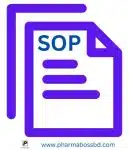Learn how to write a standard procedure SOP for calibration of Karl Fischer apparatus (KF) in quality control laboratory in pharmaceuticals.
1. PURPOSE
To describe the process for the calibration of Karl Fischer (KF) apparatus used for determining the moisture content of samples in pharmaceutical. Calibration ensures that the equipment provides accurate and reproducible results.
2. SCOPE
This SOP is applicable to all personnel operating the Karl Fischer apparatus in the laboratory and ensures the proper calibration of the device before use for moisture determination. It includes steps for calibration, verification, and maintenance.
3. RESPONSIBILITIES
3.1 Executive Analytical /Technician: Performs the calibration of the KF apparatus and ensures it meets accuracy criteria.
3.2 Quality Control (QC) Manager: Ensures compliance with the calibration schedule and supervises personnel involved in calibration. Finally reviews and approves calibration results.
4. ACCOUNTABILITY
Head of the Quality Assurance Department
5. ASSOCIATED DOCUMENTS / REFERENCES
5.1 Manufacturer’s User Manual for Karl Fischer Apparatus.
5.2 ICH Q2 (R2): Validation of Analytical Procedures: Text and Methodology.
6. PRECAUTIONS
6.1 Wear appropriate personal protective equipment (PPE), such as gloves and safety goggles, when handling KF reagents.
6.2 Follow the manufacturer’s safety guidelines when working with reagents and the apparatus.
6.3 Ensure proper ventilation in the lab when using volatile solvents.
7. PROCEDURE
7.1 Equipment and Materials
7.1.1 Karl Fischer Titration apparatus (e.g., potentiometric, volumetric)
7.1.2 Karl Fischer reagent (e.g., iodine solution, solvent)
7.1.3 Calibration standard (e.g., water standard or certified moisture standard)
7.1.4 Analytical balance (accurate to 0.0001 g)
7.1.5 Drying oven (optional, if moisture content must be reduced to a specific level)
7.1.6 Titration vessel and other required accessories
7.2 Preparation
7.2.1 Ensure that all parts of the Karl Fischer apparatus (vessel, electrodes, and reagent lines) are clean and dry.
7.2.2 Ensure that the Karl Fischer reagent is fresh, properly mixed, and free of contaminants.
7.2.3 Check the Reagent Volume and verify that the reagent is at the correct level and replace it if necessary.
7.3 Calibration of the Apparatus
7.3.1 Tare the Vessel: Weigh the empty titration vessel on the analytical balance and record the weight.
7.3.2 Add Calibration Standard: Add a known moisture content standard (e.g., certified water standard) into the titration vessel, accurately recording its weight.
7.3.3 Set the Parameters: Input the proper parameters for the titration on the KF apparatus (e.g., titration speed, end point criteria).
7.3.4 Start the Titration: Begin the titration process. The apparatus will dispense the Karl Fischer reagent until the moisture content of the sample reaches the predetermined endpoint (as indicated by the instrument).
7.3.5 Record the Result: Once the titration is complete, record the volume of reagent used and compares the calculated moisture content with the known moisture content of the standard.
7.3.6 Acceptable Calibration Range: The difference between the known and calculated moisture content should not exceed ±0.5% of the standard’s value.
7.4 Adjustment of the Apparatus
7.4.1 If the calculated moisture content is outside the acceptable range, adjust the Karl Fischer apparatus according to the manufacturer’s instructions.
7.4.2 Recalibrate using the same standard and check if the result falls within the acceptable range.
7.5 Verification
7.5.1 After calibration, run a second test using a different standard or sample with a known moisture content to verify the accuracy of the apparatus.
7.5.2 The results should fall within the acceptable range (e.g., ±0.5% of the known moisture content).
7.6 Documentation and Records
7.6.1 Record all calibration data, including the weight of the sample, the volume of reagent used, and the calculated moisture content.
7.6.2 Maintain calibration records in the laboratory’s logbook or electronic records system for traceability and future audits.
7.6.3 Review and approve calibration data by the appropriate personnel (e.g., QC or Lab Manager).
7.7 Frequency of Calibration
7.7.1 Daily Calibration: Perform calibration at the start of each working day before using the Karl Fischer apparatus for moisture determination.
7.7.2 Post-Maintenance Calibration: Calibrate after any maintenance or significant repairs to the apparatus.
7.7.3 Routine Calibration: Periodically (e.g., every 30 days) to ensure the equipment remains within the required accuracy.
7.8 Troubleshooting of the Calibration
7.8.1 If the Karl Fischer apparatus consistently gives inaccurate results, check the following:
7.8.2 Ensure the reagent is fresh and correctly prepared.
7.8.3 Check for contamination in the reagent or apparatus.
7.8.4 Verify the sample size and weight accuracy.
7.8.5 Ensure that the electrodes are clean and functioning correctly.
8. DEFINITIONS / ABBREVIATIONS
8.1 Karl Fischer Titration: A technique used for the precise measurement of water content in samples.
8.2 Calibration Standard: A known moisture content standard used to verify and adjust the Karl Fischer apparatus.
8.3 SOP : Standard Operating Procedure
8.4 ICH : International Council for Harmonization
8.5 PPE : Personal Protective Equipment
8.6 KF: Karl Fischer
8.7 QC: Quality Control
9. ANNEXES
9.1 Annex-1: Log Book for Calibration of Karl Fischer Apparatus
10. Revision History
| Version | Date | Description of Change | Reviewed By | Approved By |
| 1.0 |
Read Also:

Abdus Sobhan Salim is professional experienced pharmacist in pharmaceuticals, author and founder of pharmabossbd.com, the first Bangladeshi pharmaceutical blogger since 2019.



